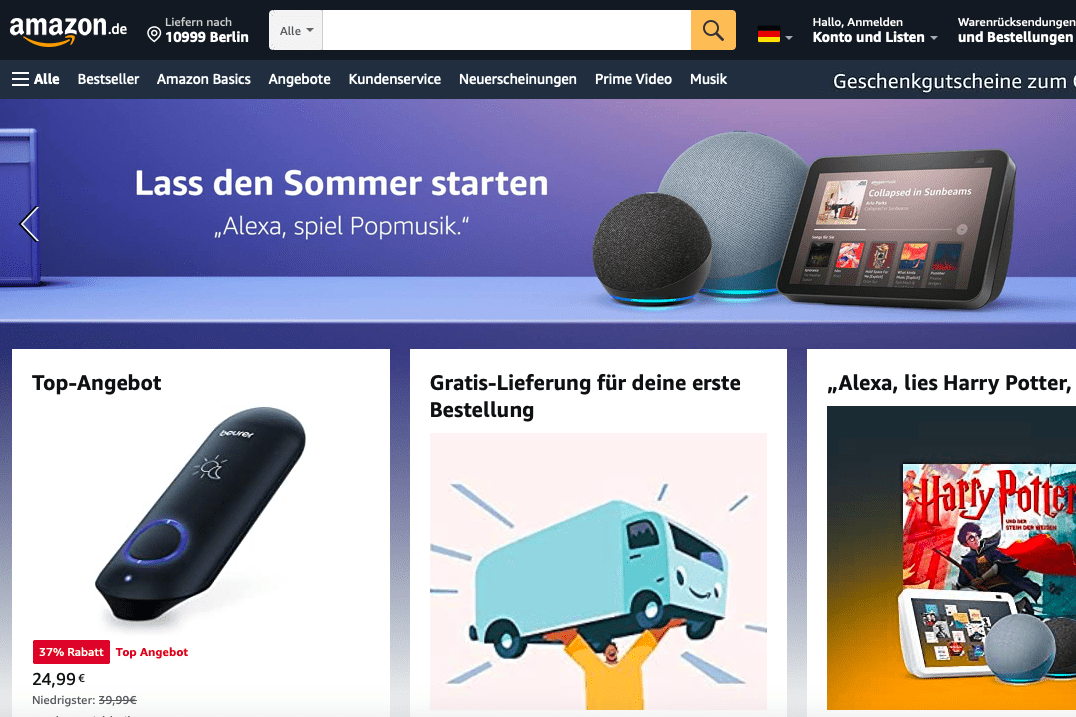Amazon has long featured in the Elite of the Top1000 Europe report. The ecommerce pioneer has been selling in Europe since its first international site opened in the UK in 1998. Today, it has eight websites operating in European markets, of which its German business was the largest in June 2022 in terms of traffic, according to analysis from RetailX Knowledge Partner, SimilarWeb.
Amazon has been selling in Germany for more than 20 years and aims to have more than 36,000 people working from more than 100 sites by the end of the 2022, including those specialising in areas such as logistics, research and development.
A key challenge is how to enable shoppers to navigate vast choice from a desktop as well as smaller smartphone screens. Amazon, brands, third-party retailers and smaller scale sellers all use its site as a marketplace, which starts by localising the experience.
The German-market website is one of 21 fully localised sites that Amazon operates around the world, of which eight are in Europe. On each, shoppers can opt to choose the language and the currency that they would prefer to pay in, while seeing relevant delivery and payments information. Shoppers can see the German website, for example, in English, Dutch, Polish, Turkish or Czech, reflecting key nationalities that shop from the website and would prefer to use it in their own language. More than half of shoppers visiting Amazon from markets including Austria, Switzerland, the Netherlands, Denmark, Finland, Poland, Czechia and Luxembourg visit the amazon.de website, according to SimilarWeb analysis. Those who go on to buy from the Amazon.de website can choose from a total of 60 currencies when paying.
Navigating the site
The site deploys both department-based navigation and recommendations to help shoppers navigate its wide range. Bestsellers and today’s deals feature on its home page alongside fashion, beauty and homewares categories. Recommendations include items that are ‘best sellers in computer and accessories’, ‘frequently repurchased in home’ or ‘most wished for in DVD & Blu-ray’. Each categories is narrowed down into key sub-categories, followed by smaller categories, with relevant ‘lightning deals’ and ‘bestsellers’ offered alongside at each stage. Shoppers can also use filters including ‘new brands’, ‘discounts on open box and used products’, delivery options, and climate pledge friendly as well as featured brands and condition.
At the product level, shoppers can see a choice of zoomable images alongside clear delivery options, the returns period, star ratings and the number of reviews that have been left. They can filter by all these features as well as by next-day delivery, price, material, occasion and more. Small businesses based in Germany are clearly marked. Shoppers can share products by email and on Pinterest, Facebook and Twitter.
Depending on the item and the delivery postcode, shoppers in Germany can take delivery as soon as the same evening. Standard shipping takes between one and two days, either for delivery to home or collection from a locker or pick-up point. This costs between €1.99 and €3.99, depending on the item being shipped, or is free to Amazon Prime members. Customers can pay with credit and gift cards, via direct debit or by invoice.
A German language app is available on both iOS and Android. Amazon does not flag up engagement with shoppers beyond the ecosystem of its home page. It doesn’t share social links, although shoppers can share products on social platforms and it has, for example, 29m followers on Facebook. It doesn’t offer a newsletter sign-up or live chat there either. However, shoppers can use the automated Amazon Alexa assistant via a broad range of devices.









